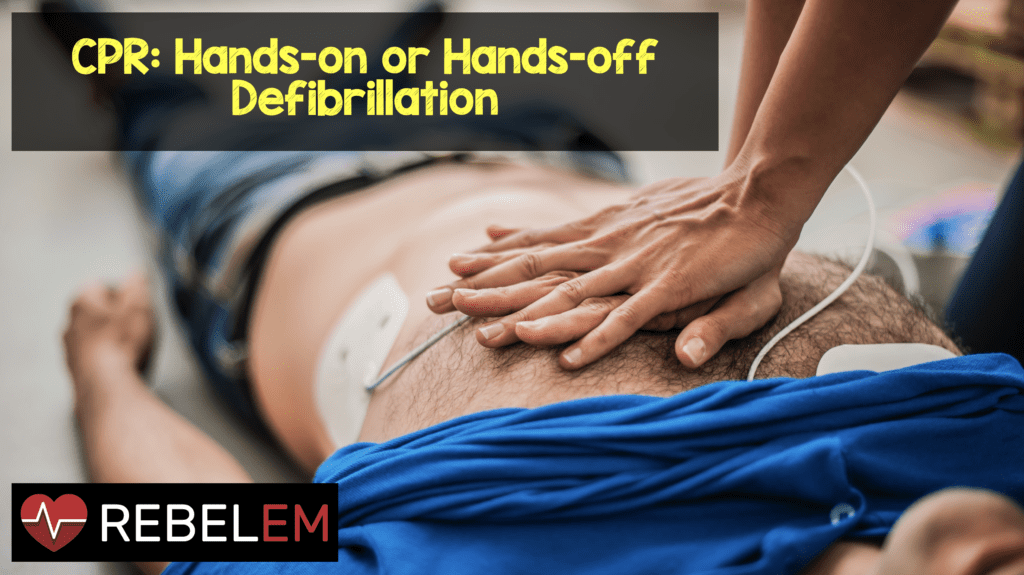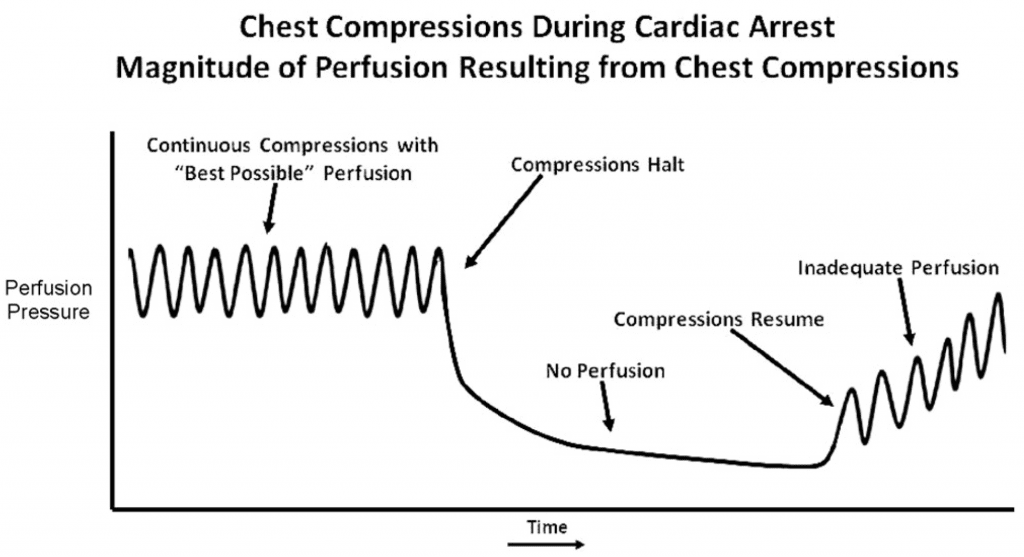
 Pauses in chest compressions are known to be detrimental to survival in cardiac arrest, so much so that the 2010 American Heart Association (AHA) emphasize high-quality compressions while minimizing interruptions. There have been some studies that now advocate for continuous chest compressions during a defibrillation shock. There have been substantial changes to external defibrillation technology including:
Pauses in chest compressions are known to be detrimental to survival in cardiac arrest, so much so that the 2010 American Heart Association (AHA) emphasize high-quality compressions while minimizing interruptions. There have been some studies that now advocate for continuous chest compressions during a defibrillation shock. There have been substantial changes to external defibrillation technology including:
- Biphasic shocks with real-time impedance monitoring to reduce peak voltages
- Paddles being replaced by adhesive pre-gelled electrodes
- Enhancement in ECG filtering permitting rhythm monitoring during chest compressions.
So the mantra of “hard and fast” may be true when it comes to CPR, but the real question now becomes, should we be continuing CPR during defibrillation?
How important is uninterrupted chest compressions in cardiac arrest resuscitation? [1] [2]

- It has been well documented in several swine models that coronary perfusion pressure decreases with interruptions in chest compressions.
- Furthermore, it takes several minutes of chest compressions to build up to an adequate coronary perfusion pressure.
Does increased coronary perfusion pressure (CPP) correlate with the chance of return of spontaneous circulation (ROSC)? [3]
- 100 patients with cardiac arrest
- Only patients with maximal CPPs of 15 mm Hg or more had ROSC
- A CPP > 15 mm Hg did not guarantee ROSC
- Conclusion: Increased CPP correlates with increase chance of ROSC
How important are pauses in chest compressions prior to defibrillation? [4]
- 815 patients with out of hospital cardiac arrest (OHCA)
- Pre-shock chest compression pause ≥ 20 seconds had OR 0.47 for survival vs pauses < 10 seconds
- Pre-shock chest compression pause ≥ 40 seconds had OR 0.54 for survival vs pauses < 20 seconds
- Conclusion: Longer periods of pre- and peri-shock pauses independently are associated with decrease chance of survival
If continuous, uninterrupted CPR improves coronary perfusion pressure, which in turn increases the likelihood of ROSC, and pre-/peri-shock pauses in CPR negatively affect the likelihood of ROSC, maybe continuous CPR through defibrillation is a good idea.
Well, wait just one second before we draw any final conclusions…
What is the evidence for continuous hands-on CPR during defibrillation? [5]
- 43 hands-on shocks (4 at 100J, 27 at 200J, and 8 at 360J)
- None of the shocks were perceptible to the rescuers, who wore polyethylene gloves
- 11.1% of shocks exceeded the allowable 0.5 mA of current leakage
- Authors’ Conclusion: Uninterrupted CPR during shock delivery is feasible
- My thoughts: Although these were low levels of electricity, just over 1 in 10 rescuers received more than the allowable minimum shock from doing hands-on CPR! I would question the conclusion of this study.
Do medical examination gloves protect rescuers from defibrillation during hands-on CPR? [6]
- 4 types of medical gloves tested (chloroprene, latex, nitrile, and vinyl) with external defibrillation
- Single glove and double glove both tested
- Concerning: 45% of single gloves and 77% of double gloves allowed at least 0.1 mA of current flow with external defibrillation
- Very concerning: 7.5% of single gloves and 6.2% of gloves allowed at least 10 mA of current flow with external defibrillation
- Conclusion: Few of the tested gloves limit the current to levels proven to be safe
Final Thoughts
Currently, I do not feel there is sufficient evidence to perform hands-on defibrillation safely, but do agree that minimizing peri-shock pauses in CPR is a must. Would love others thoughts on this.
Other Thoughts:
- All NYC EM Conference Lecture February 2015: CPR That Saves Lives
References:
- Cunningham LM et al. Cardiopulmonary Resuscitation for Cardiac Arrest: The Importance of Uninterrupted Chest Compressions in Cardiac arrest Resuscitation. AJEM 2012. PMID: 22633716
- Berg RA et al. Adverse Hemodynamic Effects of Interrupting Chest Compressions for Rescue Breathing During Cardiopulmonary Resuscitation for Ventricular Fibrillation Cardiac Arrest. Circ 2001. PMID: 11705826
- Paradis NA et al. Coronary Perfusion Pressure and Return of Spontaneous Circulation in Human Cardiopulmonary Resuscitation. JAMA 1990. PMID: 2386557
- Cheskes S et al. The Impact of Peri-Shock Pause on Survival from Out-of-Hospital Shockable Cardiac arrest During The Resuscitation Outcomes Consortium PRIMED Trial. Resuscitation 2015. PMID: 24513129
- Lloyd MS et al. Hands-On Defibrillation: An Analysis of Electrical Current Flow Through Rescuers in Direct Contact with patients During Biphasic External Defibrillation. Circ 2008. PMID: 18458166
- Sullivan JL et al. Will Medical Examination Gloves Protect Rescuers from Defibrillation Voltages During Hands-On Defibrillation? Resuscitation 2012. PMID: 22925991
- Brady W et al. Hands-on defibrillation during active chest compressions: eliminating another interruption. Am J Emerg Med 2016. PMID: 27645811
The post CPR: Hands-on or Hands-off Defibrillation appeared first on REBEL EM - Emergency Medicine Blog.
